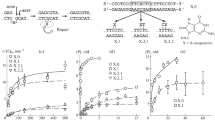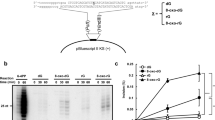Summary
The role of closely spaced lesions on both DNA strands in the induction of double-strand breaks and formation of deletions was studied. For this purpose a polylinker sequence flanked by 165 by direct repeats was inserted within the tet gene of pBR327. This plasmid was used to construct DNA containing one or two uracil residues which replaced cytosine residues in the Kpnl restriction site of the polylinker. Incubation of the plasmid DNA construct with Escherichia coli cell-free extracts showed that double-strand breaks occurred as a result of excision repair of the opposing uracil residues by uracil-DNA glycosylase (in extracts from ung + but not in extracts from ung − E. coli strains). Recombination of direct repeats, induced by double-strand breakage of plasmid DNA, can lead to the deletion of the polylinker and of one of the direct repeats, thus restoring the tet + gene function which can be detected by the appearance of tetracycline-resistant colonies of transformants. Transformation of E. coli cells with single or double uracil-containing DNAs demonstrated that DNA containing two closely spaced uracil residues was tenfold more effective in the induction of deletions than DNA containing only a single uracil residue. The frequency of deletions is increased tenfold in an ung + E. coli strain in comparison with an ung − strain, suggesting that deletions are induced by double-strand breakage of plasmid DNA which occurs in vivo as a result of the excision of opposing uracil residues.
Similar content being viewed by others
References
Abbott PJ (1985a) Stimulation of recombination between homologous sequences on carcinogen-treated plasmid DNA and chromosomal DNA by induction of the SOS response in E. coli K-12. Mol Gen Genet 201:129–132
Abbott PJ (1985b) Mutational and recombinational events in carcinogen-modified plasmid DNA: influence of host-cell repair genes. Mutat Res 145:25–34
Apler MD, Ames BN (1975) Positive selection of mutants with deletions in gal regions of Salmonella chromosome as a screening procedure for mutagens that cause deletions. J Bacteriol 121:259–266
Bachmann BJ (1987) Derivations and genotypes of some mutant derivatives of Escherichia coli K-12. In: Neidhardt FC, Ingraham JL, Low KB, Magasanik B, Schaechter M, Umbarger HE (eds) Escherichia coli and Salmonella typhimurium cellular and molecular biology. American Society for Microbiology, Washington DC, pp 1190–1219
Baker RM, Haynes RN (1967) Ultraviolet-induced enhancement of recombination among lambda bacteriophages in ultravioletsensitive host bacteria. Mot Gen Genet 100:166–177
Bonura T, Smith KC (1975) Enzymatic production of deoxyribonucleic acid double-strand breaks after ultraviolet irradiation of Escherichia coli. J Bacteriol 121:511–517
Conley EC, Saunders VA, Jackson V, Saunders JR (1986) Mechanisms of intramolecular recyclization and deletion formation following transformation of E. coli with linearized plasmid DNA. Nucleic Acids Res 14:8919–8931
Cox MM, McEntee K, Lehman IR (1981) A simple and rapid procedure for the large scale purification of the RecA protein of E. coli. J Biol Chem 265:4676–4678
Dianov GL, Vasiunina EA, Ovchinnikova LP, Sinitsina OL, Salganik RI (1986) The molecular basis of the origin of complete and mosaic mutants. Mutat Res 159:41–46
Dianov GL, Kuzminov AV, Mazin AV, Salganik RI (1991) Molecular mechanism of deletion formation in Escherichia coli plasmids. Mol Gen Genet, in press
Duncan BK, Rockstroth PA, Warner HR (1978) Escherichia coli K-12 mutants deficient in uracil-DNA glycosylase. J Bacteriol 134:1039–1045
Harm W (1968) Effect of dose fraction on ultraviolet survival of Escherichia coli. Photochem Photobiol 7:73–86
Ishii Y, Kondo S (1975) Comparative analysis of deletion and base-change mutabilities of E. coli B strains differing in DNA repair capacity (wild type, uvrA−, polA−, recA−) by various mutagens. Mutat Res 22:81–83
Kokontis JN, Vaughan J, Harvey RG, Weiss SB (1988) Illegitimate recombination induced by benzo[a]pyrene diol epoxide in Escherichia coli. Proc Natl Acad Sci USA 85:1043–1046
Lin F-L, Sperle K, Sternberg N (1984) Model for homologous recombination during transformation of DNA into mouse cells: role for DNA ends in the recombination events. Mol Cell Biol 4:1020–1034
Lindahl T (1982) DNA repair enzymes. Annu Rev Biochem 51:61–87
Lu A-L, Clark S, Modrich P (1983) Methyl-directed repair of DNA base-pair mismatches in vitro. Proc Natl Acad Sci USA 80:4639–4642
Mandel M, Higa A (1970) Calcium-dependent bacteriophage DNA infection. J Mol Biol 53:159–162
Maniatis T, Fritsch EF, Sambrook J (1982) Molecular cloning: a laboratory manual. Cold Spring Harbor Laboratory Press, New York
Medvedev OA, Timchenko TV, Dianov GL (1988) The method for inducing G-C transition in restriction sites containing cytosines. Bioorg Khim (Russian) 14:694–696
Roth DB, Potter TN, Wilson JH (1985) Mechanisms of nonhomologous recombination in mammalian cells. Mol Cell Biol 5:2599–2607
Salganik RI, Dianov GL, Vasiunina EA, Ovchnnikova LP, Sinitsina OI (1984) Induction of deletions and insertions by sitespecific chemical modification of plasmid DNA. Proc Acad Sci USSR 274:1483–1488
Salganik RI, Timchenko TV, Dianov GL (1987) Molecular mechanisms of deletions induced by DNA double-strand breaks. Proc Acad Sci USSR 296:226–230
Setlow RB (1968) The photochemistry, photobiology and repair of polynucleotides. Prog Nucleic Acid Res Mol Biol 8:257–259
Shapiro R, DiFate V, Welcher M (1974) Deamination of cytosine derivatives by bisulfite. Mechanism of the reaction. J Am Chem Soc 96:206–212
Symington LS, Morrison P, Kolodner R (1985) Intramolecular recombination of linear DNA catalyzed by the Escherichia coli RecE recombination system. J Mol Biol 186:515–525
Tessman I (1962) The induction of large deletions by nitrous acid. J Mol Biol 5:442–445
Wei S-J, Desai SM, Harvey RJ, Weiss LB (1984) Use of short DNA oligonucleotides for determination of sequence modification induced by benzo[α]pyrene diol epoxide. Proc Natl Acad Sci USA 81:5936–5940
Weisberg RA, Adhya S (1977) Illegitimate recombination in bacteria and bacteriophage. Annu Rev Genet 11:451–473
Author information
Authors and Affiliations
Additional information
Communicated by R. Devoret
Rights and permissions
About this article
Cite this article
Dianov, G.L., Timehenko, T.V., Sinitsina, O.I. et al. Repair of uracil residues closely spaced on the opposite strands of plasmid DNA results in double-strand break and deletion formation. Molec. Gen. Genet. 225, 448–452 (1991). https://doi.org/10.1007/BF00261686
Received:
Issue Date:
DOI: https://doi.org/10.1007/BF00261686




